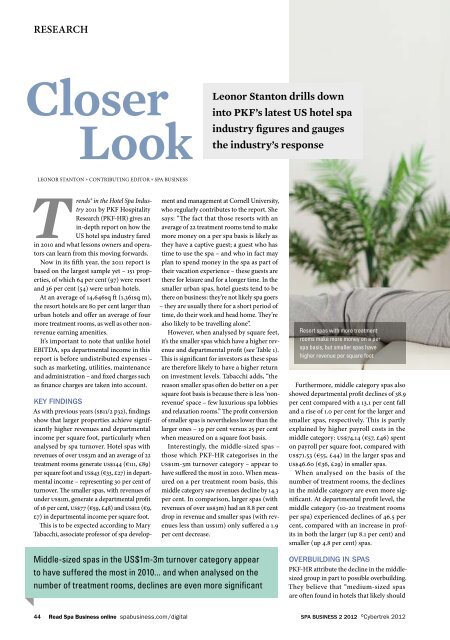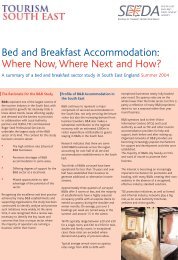Spa Business issue 2 2012 - Leisure Opportunities
Spa Business issue 2 2012 - Leisure Opportunities
Spa Business issue 2 2012 - Leisure Opportunities
Create successful ePaper yourself
Turn your PDF publications into a flip-book with our unique Google optimized e-Paper software.
RESEARCH<br />
������<br />
����<br />
LEONOR STANTON » CONTRIBUTING EDITOR » SPA BUSINESS<br />
�rends® in the Hotel <strong>Spa</strong> Industry<br />
2011 by PKF Hospitality<br />
Research (PKF-HR) gives an<br />
in-depth report on how the<br />
US hotel spa industry fared<br />
in 2010 and what lessons owners and operators<br />
can learn from this moving forwards.<br />
Now in its fi ft h year, the 2011 report is<br />
based on the largest sample yet – 151 properties,<br />
of which 64 per cent (97) were resort<br />
and 36 per cent (54) were urban hotels.<br />
At an average of 14,646sq ft (1,361sq m),<br />
the resort hotels are 80 per cent larger than<br />
urban hotels and off er an average of four<br />
more treatment rooms, as well as other nonrevenue<br />
earning amenities.<br />
It’s important to note that unlike hotel<br />
EBITDA, spa departmental income in this<br />
report is before undistributed expenses –<br />
such as marketing, utilities, maintenance<br />
and administration – and fi xed charges such<br />
as fi nance charges are taken into account.<br />
KEY FINDINGS<br />
As with previous years (sb11/2 p32), fi ndings<br />
show that larger properties achieve significantly<br />
higher revenues and departmental<br />
income per square foot, particularly when<br />
analysed by spa turnover. Hotel spas with<br />
revenues of over us$3m and an average of 22<br />
treatment rooms generate us$144 (€111, £89)<br />
per square foot and us$43 (€33, £27) in departmental<br />
income – representing 30 per cent of<br />
turnover. Th e smaller spas, with revenues of<br />
under us$1m, generate a departmental profi t<br />
of 16 per cent, us$77 (€59, £48) and us$12 (€9,<br />
£7) in departmental income per square foot.<br />
Th is is to be expected according to Mary<br />
Tabacchi, associate professor of spa develop-<br />
44 Read <strong>Spa</strong> <strong>Business</strong> online spabusiness.com / digital<br />
���������������������������<br />
�������������������������������<br />
����������������������������<br />
�����������������������<br />
ment and management at Cornell University,<br />
who regularly contributes to the report. She<br />
says: “Th e fact that those resorts with an<br />
average of 22 treatment rooms tend to make<br />
more money on a per spa basis is likely as<br />
they have a captive guest; a guest who has<br />
time to use the spa – and who in fact may<br />
plan to spend money in the spa as part of<br />
their vacation experience – these guests are<br />
there for leisure and for a longer time. In the<br />
smaller urban spas, hotel guests tend to be<br />
there on business: they’re not likely spa goers<br />
– they are usually there for a short period of<br />
time, do their work and head home. Th ey’re<br />
also likely to be travelling alone”.<br />
However, when analysed by square feet,<br />
it’s the smaller spas which have a higher revenue<br />
and departmental profi t (see Table 1).<br />
Th is is signifi cant for investors as these spas<br />
are therefore likely to have a higher return<br />
on investment levels. Tabacchi adds, “the<br />
reason smaller spas oft en do better on a per<br />
square foot basis is because there is less ‘nonrevenue’<br />
space – few luxurious spa lobbies<br />
and relaxation rooms.” Th e profi t conversion<br />
of smaller spas is nevertheless lower than the<br />
larger ones – 19 per cent versus 25 per cent<br />
when measured on a square foot basis.<br />
Interestingly, the middle-sized spas –<br />
those which PKF-HR categorises in the<br />
us$1m-3m turnover category – appear to<br />
have suff ered the most in 2010. When measured<br />
on a per treatment room basis, this<br />
middle category saw revenues decline by 14.3<br />
per cent. In comparison, larger spas (with<br />
revenues of over us$3m) had an 8.8 per cent<br />
drop in revenue and smaller spas (with revenues<br />
less than us$1m) only suff ered a 1.9<br />
per cent decrease.<br />
Middle-sized spas in the US$1m-3m turnover category appear<br />
to have suffered the most in 2010... and when analysed on the<br />
number of treatment rooms, declines are even more signifi cant<br />
Resort spas with more treatment<br />
rooms make more money on a per<br />
spa basis, but smaller spas have<br />
higher revenue per square foot<br />
Furthermore, middle category spas also<br />
showed departmental profi t declines of 38.9<br />
per cent compared with a 13.1 per cent fall<br />
and a rise of 1.0 per cent for the larger and<br />
smaller spas, respectively. This is partly<br />
explained by higher payroll costs in the<br />
middle category: us$74.14 (€57, £46) spent<br />
on payroll per square foot, compared with<br />
us$71.53 (€55, £44) in the larger spas and<br />
us$46.60 (€36, £29) in smaller spas.<br />
When analysed on the basis of the<br />
number of treatment rooms, the declines<br />
in the middle category are even more signifi<br />
cant. At departmental profi t level, the<br />
middle category (10-20 treatment rooms<br />
per spa) experienced declines of 46.5 per<br />
cent, compared with an increase in profits<br />
in both the larger (up 8.1 per cent) and<br />
smaller (up 4.8 per cent) spas.<br />
OVERBUILDING IN SPAS<br />
PKF-HR attribute the decline in the middlesized<br />
group in part to possible overbuilding.<br />
They believe that “medium-sized spas<br />
are oft en found in hotels that likely should<br />
SPA BUSINESS 2 <strong>2012</strong> © Cybertrek <strong>2012</strong>

















